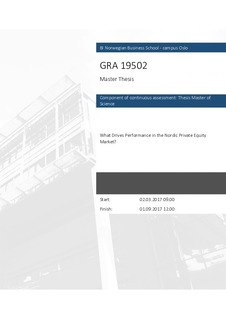What drives performance in the Nordic private equity market?
Master thesis
Permanent lenke
http://hdl.handle.net/11250/2470045Utgivelsesdato
2017Metadata
Vis full innførselSamlinger
- Master of Science [1621]
Sammendrag
In this thesis, we study the performance of Nordic private equity buyout and venture
funds between 2005 to 2016 using a dataset from Preqin. We have defined the
Nordic to include Denmark, Finland, Norway, and Sweden. By looking at fund
characteristics such as fund types, cycles, sequence number, location, and size, and
measured it on IRR1, TVPI and size, we have discovered the characteristics that
drive private equity in the Nordic. Previous research indicates that our dataset is of
high quality and shows a real picture of the private equity market. However, a pitfall
in this work is that our sample size of venture funds only consists of seven funds.
This will have an impact on the statistical results and makes it difficult to conclude
anything about venture fund performance.
Our analysis reveal that buyout funds outperform venture funds in general, which
is in line with existing work and of no surprise given our modern focus. Looking at
cycles, we find that funds raised in bust periods significantly outperform funds that
are raised in boom periods. Specifically, buyout funds raised in bust periods
perform better than buyout funds raised in boom periods. Also, we report that small
buyout funds are better than medium buyout funds, which gives evidence of a
negative correlation between performance and size. Studying the relation between
sequence number and performance, we find that funds with sequence number 1
outperform funds with sequence number 0, and that sequence number 3 is better
than 1. This means that success increase the chances of creating a follow-on fund.
These two findings are only significant when we use TVPI, and not IRR. Last, we
find that buyout funds are larger than venture funds in general, and that funds
located in Sweden are the largest in the Nordic region.
We believe our findings sets the ground for further research on many things.
Specially, it would be interesting to relate Nordic PE performance to a relevant
benchmark. Also, we think a closer look on the GPs ability to create abnormal return
will be of high interest. Last, we suggest that it could be relevant to include real
estate funds in the study of Nordic PE because it is such a major part of the Nordic
economy.
Beskrivelse
Masteroppgave(MSc) in Master of Science in Finance - Handelshøyskolen BI, 2017
